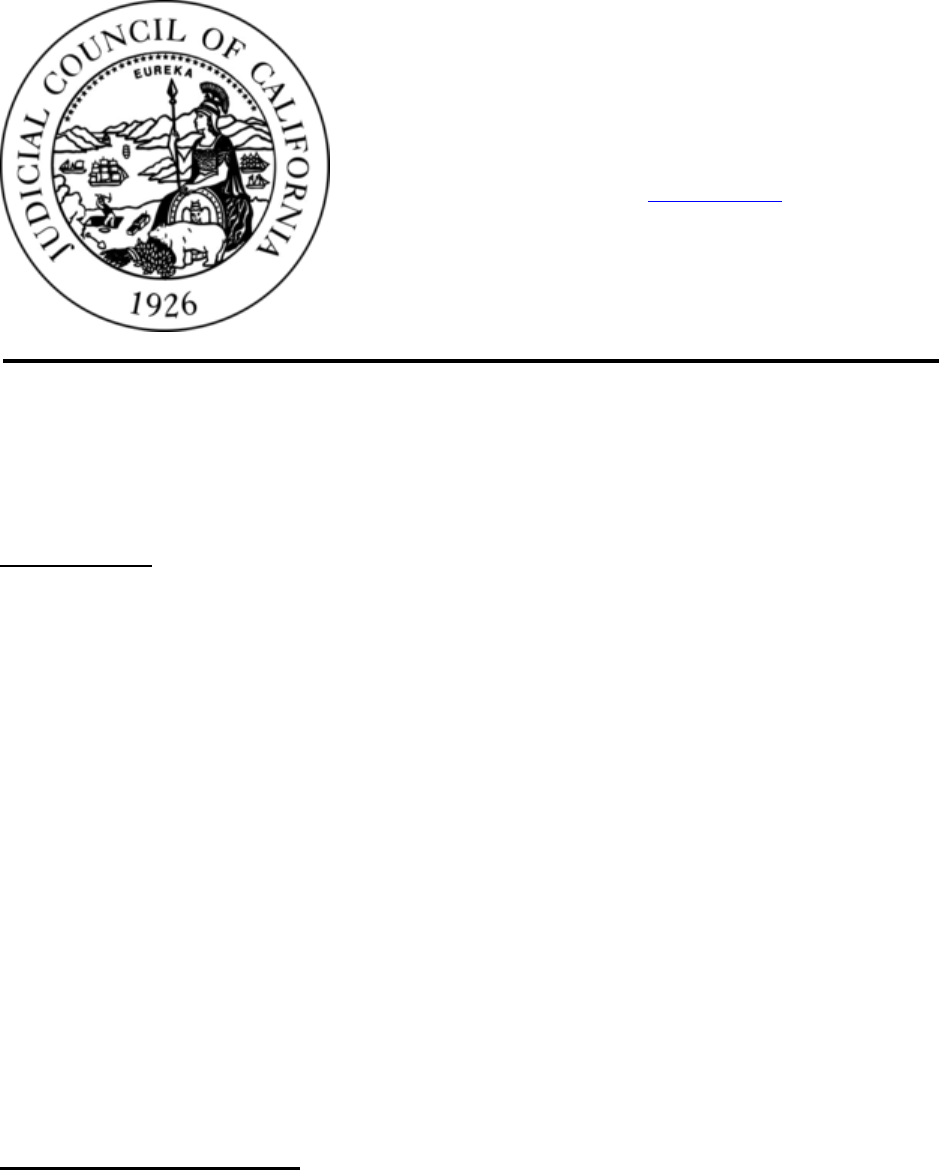
J
UDICIAL COUNCIL OF CALIFORNIA
455 Golden Gate Avenue, 5
th
Floor
San Francisco, CA 94102-3688
Tel (415) 865-4200
Fax (415) 865-4586
TDD (415) 865-8004
www.courts.ca.gov
FACT SHEET
April 2023
One Day or One Trial Jury Service
One day or one trial jury service is a statewide policy designed to improve jury service in
California.
How It Works
C
alifornians are required to participate in jury service only once every 12 months. There are four ways to
fulfill this obligation:
1. B
e assigned to on-call or standby jury service. The juror telephones the court or visits a Web site t
o
det
ermine if they must appear in person. A potential juror may serve no more than 1 day on on-cal
l
service or 5 days on standby telephone service. The option selected for the juror varies by court.
Serving on-call or on standby satisfies the juror’s obligation.
2. A
ppear in person for jury service. The juror appears in person at the courthouse. If they are not
chosen for a trial or assigned to a courtroom for jury selection on the first day of scheduled service,
they have satisfied this obligation.
3. A
ppear in person for jury service, be assigned to a courtroom for jury selection, but not be chosen for
a trial. Dismissal by a judicial officer satisfies the juror’s obligation.
4. A
ppear in person for jury service, be assigned to a courtroom for jury selection, and be chosen for a
trial. Service in that trial to verdict or until dismissed by the judicial officer satisfies the juror’s
obligation.
W
hile jury service is required by state law, the courts recognize that it impacts businesses and
employees. The one day or one trial system is designed to reduce unproductive waiting time of jurors as
well as the potential for lost income, and it reduces the uncertainty of when and for how long employees
will be unavailable for work.
Examples of How it Works
1. A
prospective juror is on-call for 1 day without ever being called to arrive at the courthouse. That
person has completed their service.
2. A
prospective juror is on telephone standby for 5 days but is never called to arrive at the courthouse.
That person has completed their service.

One Day or One Trial Jury Service
Page 2 of 2
3. A prospective juror is on-call or standby but is then required to arrive at the courthouse for
assignment to a jury panel. They are sent to a courtroom and questioned, only to be dismissed. That
person has completed their service.
4. A
prospective juror is on-call or standby but is then required to arrive at the courthouse for
assignment to a jury panel. They are sent to a courtroom and questioned. However, the judge
instructs them to return to the jury assembly room. They are not assigned to another jury panel by the
end
of the day. That person has completed their service.
5. A pr
ospective juror serves on-call or standby but is then required to arrive at the courthouse for
assignment to a jury panel. They are sent to a courtroom and given a questionnaire to complet
e
before the end of the day and asked to report back on a given day next week. They return but are not
questioned and dismissed. That person has completed their service.
6. I
n certain courts, a prospective juror may be dismissed before their summons date arrives, meani
ng
t
hey did not serve in-person, on call, or on telephone standby. In which case, those prospective jurors
may be returned to the jury pool to be resummoned for service in less than 12 months.
History
T
he Judicial Council adopted rule 2.1002 of the California Rules of Court and enacted the one-day or
one-trial policy in state courts effective July 1, 1999. At the time the rule was adopted, more than 20
superior courts in California’s 58 counties reported they had already adopted a one day or one trial
system. By May 2002, with the successful implementation of one day or one trial jury service at the
Superior Court of Los Angeles County, the new system was effective statewide.
Rule 2.1002—Length of juror service
C
alifornia Rules of Court, rule 2.1002(c) states that:
“Eac
h trial court system must implement a juror management program under which a person has fulfilled
[their] jury service obligation when the person has:
“(1) Served on one trial until discharged;
“(2) Been assigned on one day to one or more trial departments for jury selection and served through the
completion of jury selection or until excused by the jury commissioner;
“(3) Attended court but was not assigned to a trial department for selection of a jury
before the end of that day; “(4) Served one day on call; or
“(5) Served no more than five court days on telephone standby.”
Benefits for Employees and Employers
T
he one day or one trial system takes the waiting out of jury duty and reduces the potential for lost
income for both employees and employers. Before the system was enacted, prospective jurors had to be
available for up to 10 days in some counties. Now, potential jurors need to report for only one day to find
out whether they will continue to serve. The system also reduces uncertainly about when and for how
long employees will be unavailable for work.
California Juror Web Site
F
or more information on the one day or one trial jury system, visit the Jury Information Resource Center
on the California Courts Web site at http://www.courts.ca.gov/juryservice.htm.
Contact:
Stephen Michael Tow, Senior Analyst, Jury Improvement Program Lead Staff, at JuryInfo@jud.ca.gov
Originally created January 2016
